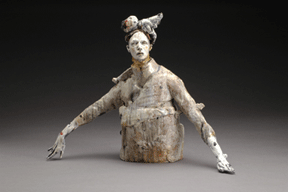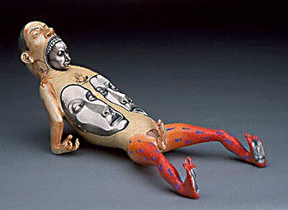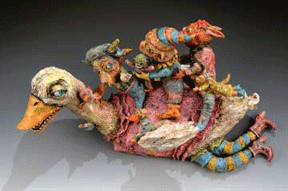I made it to the Figure It Out, Figurative Ceramic Symposium at Francis Marion University in Florence, SC, held on Mar. 5, 2011. The symposium started at 6:30pm and was scheduled to run to 8:30pm, which was already a challenge for me, being two hours away and rain in the forecast. I knew I’d be lucky to get back home by 11pm and as it turned out technical difficulties caused the presentation to run late, but it was worth it. I wish I could have hung around after, but the clock is always ticking with me and I had too many questions to ask that would have run far into the night. And after all, this symposium seemed to be mostly for the students at FMU. There were about 200 people in attendance.
The guest speakers for the symposium were Cristina Cordova, from Penland, NC (born in Puerto Rico); Sergei Isupov, from Cummington, MA (born in Russia); and Janis Mars Wunderlich, from Columbus, OH. They had given demos and worked with students during the day. Like most events at colleges and universities – the main focus is on students, as it should be, and usually the public is invited to participate as an extra for the local community. I went as an observer – not a participant. I’m not a ceramic artist, nor do I ever hope to be, I’m a communicator.
I arrived at FMU early enough to get a few photos of the Francis Marion sculpture on campus and hopefully a look at the ceramic exhibit on view at the Hyman Fine Arts Center. I was surprised that the space was open. I guess they kept it open because of the symposium. While there, I ran intoPatz Fowle, a local figurative ceramic sculptor who was also there for the symposium. It was Fowle who turned me on to the symposium to begin with. We didn’t get to talk, as the symposium was going to start soon.
The three speakers selected for the symposium made for a diverse view of artists working in the figurative ceramics field. Each gave a presentation, showing their work, and talking about creative challenges and their working lives. They all had interesting backgrounds, created fantastic works, and described colorful ascensions to their current positions (well regarded) in their chosen field.
After their presentations a panel discussion began with the three artists, co-moderated by Dr. Howard Frye, Assistant Professor of Art Education and Coordinator of the Art Education Program and Doug Gray, Professor of Visual Arts – Ceramics and Sculpture, both at FMU. The topic of the discussion was: The Development of Personal Imagery.
There was a brief question and answer period after the discussion period and the event was over. I didn’t ask any questions as I was playing the part of the observer and as I said before – I had too many questions to even get started, but I do have one observation.
Over all, the symposium did a good job of giving students and others attending a look at three individuals who have gained a level of success in their careers. They covered their backgrounds, their influences, creative process, and struggles to stay focused and motivated, but there were only hints at the other side of the artful life – the business side.
Cordova talked a little about the pressures of success and cultural heritage; Isupov hinted at troubles dealing with the public and dealers; and Wunderlich talked about the challenge to find time to work in a house full of children (five, from 1st grade to college) and being an artist/mother. But there was never a full on discussion of the business side of the art world – the side that will be the biggest challenge to any of these students if they choose the life of an artist.
Cordova, who still works with students at the Penland School of Crafts admitted that she was never prepared in school for the business side of the arts. And, it wasn’t until she had a three year residency at Penland that she learned many of the components to becoming a successful artist – in business.
As I’ve said many times – money is the mother’s milk of the arts – without it not much happens. The parents of these students are not looking forward to their children returning from university to turn the family garage into a studio and to cover room and board forever. Time may seem free, but supplies and equipment are not. So, money makes the arts go round and there was little discussion about it at this symposium – which maybe would have been off topic, but when will students in the arts be given that wakeup call?
I would have liked to know: what price these artists’ works sold for? Do they do more exhibiting than selling? How often do they sell? Are they selling enough to be making a living at it? All had spouses, Cordova’s husband was a glass artist – so maybe two artists are better than one, and perhaps the others rely on the incomes of their spouses for living expenses? I don’t know, but I know the students at that symposium don’t have a clue of what’s waiting for them. Little hints were all they got and my bet is most of them were over their heads.
What about dealing with the public that only sees artists in one light – as people who are different from the rest of us and with success comes fame and its demands. What about dealing with galleries and dealers – it can’t be all smooth sailing. And, how about taxes, marketing, marriage, children, mortgages, etc. – the other stuff that will make or break an artist. These folks must of had a wealth of answers on these subjects.
Of course the challenges are different for each artist, but the goal is the same. How do I get to create what I want and have a life – make a living – at the same time? Not all at first, but eventually.
That’s some of the reality I’d like to see discussed more at art schools – in every opportunity possible.
This is not the failing of Francis Marion University, it’s a basic problem with all art education programs – at least most I’ve had contact with directly or with their by-products, as the owner of a gallery dealing with artists who wanted to have exhibits as if I was a publicly funded museum and as a publisher of an arts newspaper where artists want publicity – of any kind – many just because they created something.
That’s the kind of symposium I’d like to see, and I’m not talking about the kind where they want artists to pay a $100 to listen to professional talkers telling them what they should do. I’m talking about real artists who have been through the gauntlet of life, who are not afraid to tell their secrets, their nightmares, their tricks, while creating more competition for themselves. And, all for free – for their future peers.
Art can be a career, but it “ain’t” easy. Let’s have more discussions about the business side of the arts.


